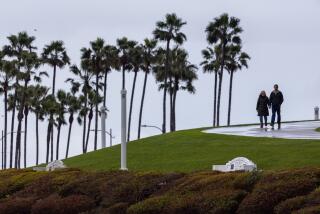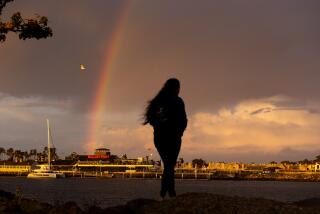Year’s First Rain Arrives; 2 More Storms Expected
The first rain of 1996 began falling Tuesday afternoon on the parched Los Angeles Basin, triggering a rash of rush-hour traffic accidents. Forecasters said a second storm could arrive late Friday, with a third due late Sunday or early Monday.
“None of them will bring real heavy rain to Southern California, but they could bring light to moderate precipitation, and that’s a change,” said Rob Kaczmarek, a meteorologist with WeatherData Inc.
As of noon Tuesday, only 1.45 inches of rain had fallen in downtown Los Angeles since the meteorological season began July 1. That compared to a normal total for the date of 6.3 inches and a total at this time last year of 11.76 inches.
Because of conservation measures, careful planning by water officials and much heavier precipitation in the northern half of the state--from which Southern California gets much of its drinking and irrigation water--reservoirs are so full that no one is worried about a drought, at least not yet.
But Southland farmers, ski resort operators and lovers of inclement weather have been wondering why--in what is usually one of Southern California wettest months--it’s been so sunny here lately. The last time it rained was a few days before Christmas, more than three weeks ago.
Kaczmarek said the dry weather has been caused by some persistent ridges of high pressure that stretched across central California, Nevada and Utah, blocking the normal, southward flow of wet storm systems from the Gulf of Alaska. Detouring north around the high pressure, these storms contributed to the miserable weather in the East.
Finally, toward the end of last weekend, the high pressure began breaking down. The high-altitude jet stream winds that carry storm systems around the world started swinging south toward Los Angeles, and by Tuesday afternoon, the southern edge of a fairly substantial storm started dropping light rain on Southern California.
Traffic was tied up during the evening rush hour as vehicles spun out of control on rain-slicked streets.
Three of the worst accidents involved big rigs, one of them a truck that skidded out of control on the 605 Freeway in the city of Industry, leaving the cab dangling over a bridge railing. Despite all the accidents, there were no reports of serious injury.
“The storm got here a little quicker than we thought, so it’ll leave a little quicker, too,” Kaczmarek said.
By the time the skies start clearing during this morning’s rush hour, he said, about a quarter to a third of an inch of rain should have fallen on downtown Los Angeles, with perhaps twice that much in some of the foothill communities. The snow levels in the San Gabriel and San Bernardino mountains will be between 6,000 and 7,000 feet, with up to six inches at some of the higher elevations.
The storm track is expected to remain where it is for a week or more, so at least two more storms could reach the Southland, the first on Friday night and the second on Sunday night. Like the storm that arrived here Tuesday, both are fairly substantial, but both are expected to concentrate most of their power on the northern half of the state.
Wind-driven rain pelted Northern California on Tuesday, downing power lines and snarling traffic. Heavy snow fell in the High Sierra, with as much as two feet expected at Lake Tahoe.
More to Read
Sign up for Essential California
The most important California stories and recommendations in your inbox every morning.
You may occasionally receive promotional content from the Los Angeles Times.










